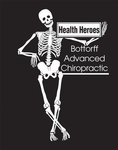

Is your New Year’s resolution to get in shape dwindling? This week’s Health Hero Mark Elizondo has some advice.
Elizondo is a previous Health Hero who came to Wabash College from Utah, a state he holds closely in his heart. He met his wife Amanda at Indiana State University while he was working on his master’s degree in athletic training. They have two children, Gabriel and Sydney. Elizondo has been with Wabash since 2006 and took over as the head trainer in 2012.
About getting started on a fitness program Elizondo observed, “The bottom line is that people jump in and do too much to soon. They over train and are so sore they have to take time off. Then six or seven days later they do the same thing again. The cycle leads to pain, injury and frustration and they quit.”
Elizondo’s biggest warning is one of unreal expectations.
“People must understand their base, where they are at on a physical level,” he pointed out. “They need to change from an athletic mentality to a fundamental mentality, learning to preform the exercises properly and avoid injury. They need to set small attainable goals.”
This is an effort that forces the ego to take a second seat. Personal coaches and trainers recognize a client’s limitations and correct poor technique to prevent injury. They can also help with a solid recovery if injury occurs. It’s difficult to improve fitness when you’re injured but you can learn your weaknesses from injury.
Elizondo sees the benefit and necessity of both static stretching where a person holds a stretch for 45 seconds or longer, and dynamic stretching which uses movement to increase joint movement and mobility. Examples of dynamic stretching are skipping or Karaoke which is a sideways movement with a cross over pattern. Stretching has shown to weaken muscle for a short period of time so it should be done 30 minutes prior to exercise to allow the muscles to recover.
When injury does occur managing recovery is key.
“Compression is important as initial treatment to keep swelling down,” Elizondo said. “Most people don’t get the injury up high enough and swelling takes place despite the compression wrap, so elevate the injured area.”
Elizondo works with ice on initial injury to preserve cell damage. He explains that chemicals from damaged cells can leak and the reaction is to draw fluids out of surrounding cells causing them to implode. Ice can effectively reduce this process.
But not all of the inflammation process is bad. Inflammation helps tear down the damaged tissue, rather a demolition before reconstruction. During this period of time keeping the formation of scar tissue down and “educating” scar tissue is key.
“Scar tissue is like a miniature wad of sticky spaghetti that covers the damaged area,” Elizondo said. “The problem is that it can cause fascia to stick to muscles, nerves and other structures causing a decreased motion and eventually pain. Using foam rollers and rolling out and doing cross-fiber with them is one way to break up these adhesions so the tissues can function normally.”
So, what is the difference between being in pain and being injured? Elizondo tells his athletes, “If the pain prevents you from doing normal movement, if it decreases your ability to perform, you are probably dealing with an injury. I would tell people if the pain goes past just the workout and has a lasting effect on your ability to do activities of daily living without relief, you might not want to ‘push through’ that.”
Slow and steady wins the race, and can be a solution for the resolution.
See you on the trail.